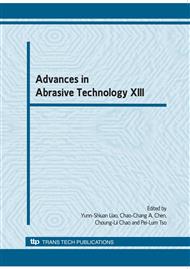p.551
p.559
p.564
p.573
p.579
p.585
p.591
p.597
p.603
Effect of Wheel Arrangement on Ground Surface Topography in Horizontal-Axis-Type Rotary Surface Grinding
Abstract:
Two grinding methods, parallel grinding and cross grinding, were applied to the horizontal-axis-type rotary surface grinding of silicon and tungsten carbide. It was found that the cross grinding method results in better ground surface roughness than parallel grinding for the silicon wafer and that an isotropic ground surface topography is achieved for both silicon and tungsten carbide by cross grinding.
Info:
Periodical:
Pages:
579-584
Citation:
Online since:
August 2010
Authors:
Price:
Сopyright:
© 2010 Trans Tech Publications Ltd. All Rights Reserved
Share:
Citation:


